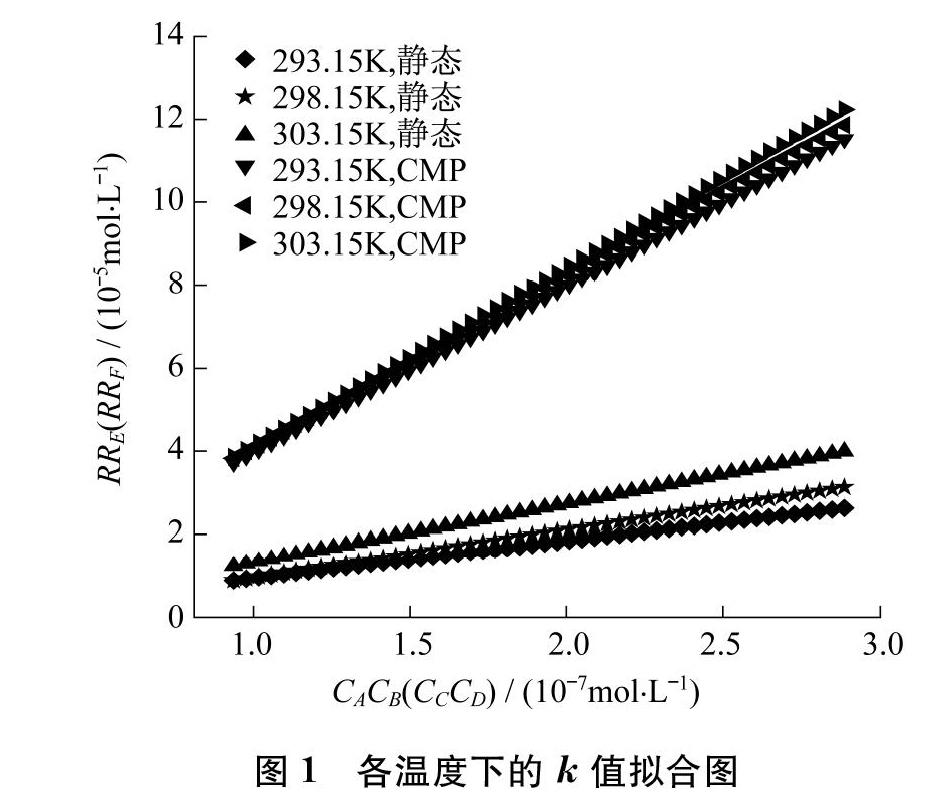摩擦化学反应活化能对CMP的影响
2016-11-24卜小峰
卜小峰



摘要:
根据质量作用定律,测定了铜膜在静态腐蚀和化学机械抛光(Chemical Mechanical Polishing,CMP)两种反应条件下的化学反应速率常数;通过Arrhenius方程,测定了铜膜在两种反应条件下的化学反应活化能.结果表明:当抛光液温度为298.15 K,工作压力为13 780 Pa时,静态腐蚀条件下体系化学反应速率常数是114.80 s-1,而CMP条件下体系的化学反应速率常数是412.11 s-1,同时,CMP条件下的反应活化能为4 849.80 J,静态腐蚀条件下的反应活化能为31 870.30 J,由此得出,反应活化能的降低是CMP过程中的机械摩擦作用所致.因此,根据CMP过程中铜膜和抛光垫各自克服滑动摩擦力所作的系统功,推导出CMP过程中活化能降低值的系统功表达式,并通过改变工作压力和转速来验证该表达式的适用性.
关键词:
质量作用定律; Arrhenius方程; 化学反应; 活化能; 机械摩擦作用
中图分类号: O 647; TN 43文献标志码: A
Abstract:
According to the law of mass action,the reaction rate constants of copper film chemical reaction are measured under static corrosion and dynamic chemical mechanical polishing (CMP) process.The activation energy of copper film chemical reaction is acquired under the two kinds of reaction conditions above mentioned based on the Arrhenius equation.The results show that:as the slurry temperature is 298.15 K with working pressure 13 780 Pa during the CMP process,and the chemicalreaction rate constant of the system under the static corrosion condition is 114.80 s-1,and the reaction activation energy is 31 870.30 J,while the reaction rate constant increases to 412.11 s-1 and reaction activation energy decreases to 4 849.80 J under the CMP condition.Thus,the mechanical friction effect in the CMP process causes the decline of activation energy as a result. Therefore,according to the system power produced by the sliding friction between the copper film and the polishing pad in the CMP process,system power expression used for describing the decline of activation energy in the CMP process is calculated. And also the applicability of the expression has been verified by changing the work pressure and speed of the CMP process.
Keywords:
law of mass action; Arrhenius equation; chemical reaction; activation energy; mechanical friction effect
化学机械抛光(Chemical Mechanical Polishing,CMP)技术是目前半导体行业的重要加工手段,是当前能够实现全局抛光的唯一实用技术.探索更加温和且更容易实现铜膜凹凸速率差的CMP工艺成为影响微电子产业发展的关键因素.大量文献证实,CMP过程中材料去除速率并非化学和机械作用的简单线性相加,而是远远大于两者单独作用之和.若再考虑到凹处和凸处不同材料的去除环境,问题将会更加复杂[1-3].部分文献[4-5]认为只要加入了BTA等一些腐蚀抑制剂,就能从根本上解决凹处速率快的问题,但并未考虑到由于机械摩擦作用而导致的钝化膜脱落现象.也有部分文献[6-7]认为,温和的反应条件即大幅度削弱机械摩擦作用,有利于实现表面的抛光.因为在低机械强度下,凹处所形成的钝化膜难以脱落,而凸处的材料却不断被去除,由此循环往复,通过延长反应时间来最终实现铜布线表面的抛光.但其并未考虑到抛光效率等因素,无法满足工业生产的需要[7].基于此现象,本文以摩擦化学反应活化能为切入点,通过质量作用定律探究了CMP过程和静态腐蚀过程的化学反应活化能的差值,并通过Preston方程和Arrhenius方程分别对铜膜的凸处和凹处的材料去除机理进行研究.
4 结论
通过静态腐蚀和CMP过程中铜离子的络合反应,阐述了CMP过程中机械作用对化学反应的影响.揭示了CMP过程中机械摩擦与化学反应的协同作用机理,即CMP条件下速率提升的原因正是因为化学反应活化能的降低,降低的数值被系统机械摩擦所产生的内能所弥补,机械作用所带来的最主要的效果是降低了化学反应的活化能,即提高了活化分子的数量.
参考文献:
[1]OH S,SEOK J.An integrated material removal model for silicon dioxide layers in chemical mechanical polishing processes[J].Wear,2009,266(7/8):839-849.
[2]TSAI T C,TSAO W C,LIN W,et al.CMP process development for the viamiddle 3D TSV applications at 28 nm technology node[J].Microeletronic Engineering,2012,92(3):29-33.
[3]ZHENG J P,ROY D.Electrochemical examination of surface films formed during chemical mechanical planarization of copper in acetic acid and dodecyl sulfate solutions[J].Thin Solid Films,2009,517(16):4587-4592.
[4]NG D,KULKARNI M,JOHNSON J.Oxidation and removal mechanisms during chemicalmechanical planarization[J].Wear,2007,263:1477-1483.
[5]PANDIJA S,ROY D,BABU S V.Achievement of high planarization efficiency in CMP of copper at a reduced down pressure[J].Microelectronic Engineering,2009,86:367-373.
[6]YANG J C,OH D W,LEE G W.Step height removal mechanism of chemical mechanical planarization(CMP) for subnanosurface finish[J].Wear,2010,268(3/4):505-510.
[7]KRISTIN G,SHATTUC K,JENG Y L,et al.Characterization of phosphate electrolytes for use in Cu electrochemical mechanical planarization[J].Electrochemical Acta,2008,53:8211-8216.
[8]王同庆,韩桂全,赵德文,等.抛光垫特性及其对300 mm晶圆铜化学机械抛光效果的影响研究[J].摩擦学学报,2013,33(4):394-399.
[9]NOH K,SAKA N,CHUN J H.Effect of slurry selectivity on dielectric erosion and copper dishing in copper chemicalmechanical polishing[J].CIRP AnnalsManufacturing Technology,2004,53(1):463-466.
(编辑:丁红艺)
